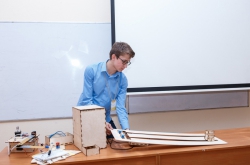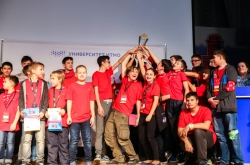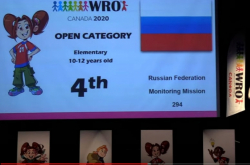"Tournament of the Two Capitals" (T2C) was first held in Moscow this spring. Back then, the St. Petersburg team won the tournament’s cup. The main purpose of the contest is to teach schoolchildren not just how to program and build robots, but also how to cope with any problems that may arise and repair or reprogram them on short notice. These skills distinguish talented roboteers from those who simply follow the manual.
Schoolchildren of two age groups: kids up to 14 years of age and kids ages 14 to 18, compete in four disciplines: the younger ones participate in "King of the Hill" and "Bridges", and the older ones in "Races" and "Swings." “King of the Hill” is, in fact, a battle between two robots resembling sumo wrestlers, trying to push each other off a small hill. In “Bridges”, two robots from the same team have to interact with each other: one paves the bridges across a gap and the second one travels across these bridges and grabs cargo. “Races” is a racing competition in which robots find their way along a route using sensors. The fourth competition, "Swings", also involves two robots: one must climb up a swing and grab a cylindrical weight from the top, while its partner keeps the swing at the right angle using its own weight. At the same time, robots are expected to work autonomously, that is, without any help from their creators.

The tasks vary slightly from tournament to tournament. This time, the starting point was changed in “King of the Hill”, the shape of the track and the conditions for entering the pit stops were changed in “Race”, the second robot, which travels along the constructed bridge, got an additional transportational task in “Bridge” and the conditions were adjusted in “Swings” to ensure that the participants complete the task and not resort to any tricks.
"It's great that every year the conditions change a little. It motivates schoolchildren to develop their skills and learn new things. The most difficult part is not always programming. Often, it is much more difficult for schoolkids to build a robot within the specified parameters: that is, a robot of a certain size. Last year we also participated in the "Tournament of the Two Capitals" and took part in the finals in Moscow. However, we did not train properly the last time because I helped the kids with some of the tasks too often. This time I tried to make sure that the children themselves would solve any emerging problems," - comments Roman Popovich, coach of one of the teams in the "Bridges" track, an employee of the educational center "StudyLand".

But the main rule did not change: the best 20 teams are selected, five in each track, at the qualifying stages in Moscow and St. Petersburg. 199 people took part in the regional qualifying round in St. Petersburg this year. They formed 116 teams, Nikolay Pshenichniy, head of ITMO’s Career Guidance and Scouting Office (available in Russian), commented. He emphasized that this time, the share of participants from the Leningrad Oblast grew: every third participant represented schools and associations from the region.
The competition took place at the Physics and Mathematics Lyceum № 30, where grounds were set up on several floors. Participants could test their robots in mock "races" and "battles" in the morning and the competition itself began in the afternoon. Several referee teams and volunteers oversaw the competition. Points were given for both technique and time of each assignment. Each team had three attempts to showcase their robots. The results of each team’s work in every track were immediately reflected on the digital panels.

Alexander Negols
According to Alexander Negols, the organizer of the tournament from ITMO and chief referee of the tournament, city qualifying competitions this year showed a higher level of skills in robotics among the participants. Stats support this fact, too: there were fewer zero results in the test races. In addition to that, this year the kids read the T2C rules carefully - and therefore, could argue their cases quite confidently with the judges.
"However, some kids are still expecting a miracle: that their robot will work as intended, even if there were malfunctions in the test races. For example, these kids pushed their robot in "King of the Hill" when he could not climb the mountain during test races. And during the competition they were not allowed to do it! So, it turned out that the participants did not solve this problem in advance: their robot stopped at the very beginning, but they still were sure that "it actually worked!" I think we should give the T2C participants some recommendations prior to the competition. In Moscow, classes were held where mistakes were pointed out to children. Also, coaches should pay attention to this. Although it’s quite difficult, as they are training several teams simultaneously," - comments Alexander Negols.
He then adds that T2C is already gradually spreading beyond the two cities. For instance, one of the schools in Ivangorod built its own training ground for the robots track "King of the Hill". Organizers hope that they can continue conveying the experience of this competition further and spread their love for robotics to school students in the regions.

ITMO.NEWS asked young roboteers why they build robots, what they expect from T2C and what is the hardest thing in creating a robot.
Artemy Permyakov, track "King of the Hill", 4th grade.
I started building robots two years ago, in the second grade. I'm very interested in it! I learned what robots are and how they can be constructed on the Internet and asked my parents to sign me up for a robotics class. I was also given a robot once as a New Year present. I construct and program the robot myself; the latter, of course, being more difficult. My robot has an infrared sensor, a light sensor and two motors.

Andrey Klyuchnikov and Alexey Maruginin
Andrey Klyuchnikov and Alexey Maruginin, track “Swings”, 8th and 9th grades.
This was the first time when we prepared our robot for such a competition as "Swings". We constructed robots which moved along a line on all previous occasions. We picked "Swings" because we wanted to learn something new and try to make another type of robot. We work as a team: one of us is better at programming, and the other is better at building a robot’s mechanism from Lego MindStorms. Here at T2C, victory is less important to us than having fun and learning new things. For both of us, robotics is probably a hobby. So, one of is determined to go to college after 9th grade and become an architect, and the other has chosen to continue his studies at high school and, maybe, later work on robots at the university.

Mikhail Medvedev (on the right)
Mikhail Medvedev, track "King of the Hill", 6th grade.
I started doing robotics in September at the local hobby center. My teacher there told me about the "Tournament of the Two Capitals". I like building robots more than programming them now. It's quite easy for me. However, I'm good at programming, too. I still have a lot of training to do, of course, because not everything works out as it should. I simply don’t know certain things about robotics yet.
Timofey Khomyakov, track "King of the Hill", 7th grade.
I decided to try my luck at the "Tournament of the Two Capitals" in order to understand how well I can compete with other guys. I didn’t know anything about such competitions earlier. I don’t know much about good half of the tracks and tasks performed here. So, it's great to see what else one can do in robotics. It’s not such a big problem to build a robot for me, but still rather difficult to program it.

Vsevolod Fedorov
Vsevolod Fedorov, track "Bridges", 8th grade.
When I had to choose which track to participate in, I had a hard time picking between "Bridges" or "King of the Hill". But fewer people usually participate in "Bridges", so the chances of winning there are relatively higher. I had prepared for T2C for two months. As soon as Lego MindStorms sets were delivered to our school, I began building my robot. I have been doing robotics for about a year already. The robot turned out quite well. However, there were problems with the software, as the two robots were made using slightly different versions. But we were able to update the program fast enough. I liked participating in this tournament and hope to be a part of various competitions in the future.

Results of the qualifying competition of the "Tournament of the two capitals" in St. Petersburg were announced on the same day. The ratio between the city and the region was the same again: one third of the prizes were received by schoolkids from the Leningrad Oblast. However, not five, but only four winners were identified in the track "Swing". Thus, there will be another qualifying round taking place in St. Petersburg, where the twentieth team representing the city will be determined. The finals of T2C are to be held at ITMO on December 14-17.
Results of the regional qualifying round of the 2nd "Tournament of the two capitals" in St. Petersburg:
King of the Hill
Winner:
Korobochka 2.0 – German Kupkin, coach Alexey Romanchuk (Kronstadt, Saint Petersburg)
Runners-up:
Sparky 2 – Daniil Ryazanov, Vsevolod Gorodetsky, coach Alexey Lakhmenev (Saint Petersburg)
E2E4 – Artem Goncharov, Andrey Panov, coach Sergey Schekoldin (Kirishi, Leningrad Oblast)
Leonardo 1 – Afanasy Zhuravlev, Vadim Lisin, coach Lyubov Kazakova (Ivangorod, Leningrad Oblast)
C-3PO – Igor Korablin, Timofey Khomyakov, coach Valeria Samsonova (Saint Petersburg)

Bridges
Winner:
Alyosha and Antosha – Anton Kuznetsov, Valery Khlyustin, coach Andrey Loginov (Saint Petersburg)
Runners-up:
Non-stop – Vsevolod Fedorov, Svyatogor Trukhachev, coach Svetlana Umnikoa (Vsevolozhsk, Leningrad Oblast)
NoName – Alexander Klyukin, coach Vyacheslav Klyukin (Tosno, Leningrad Oblast)
Kubik – Stepan Zhogolev, coach Vyacheslav Klyukin (Tosno, Leningrad Oblast)
Luzhsky Rubezh Bridges – Alexander Kuzmin, Andrey Korzyuk, coach Alexey Chistyakov (Luga, Leningrad Oblast)
Races
Winner:
Paradox – Nikolay Gareev, Rinat Shekhmametiev, coach Sergey Schekoldin (Kirishi, Leningrad Oblast)
Runners-up:
Valerochka – Valery Povelikin, Valery Khlyustin, coach Andrey Loginov (Saint Petersburg)
NKNB – Maxim Matrosov, coach Vladislav Nechaev (Saint Petersburg)
Team A1 – Artemy Toropchin, Artem Vitov, coach Daniil Nechaev (Saint Petersburg)
Vacuole – Alexey Orekhov, Alexander Polyakov, coach Mikhail Kvartin (Saint Petersburg)

Swings
Winner:
DOPE90 – Pavel Prokopiev, Dmitry Golovnev, coach Andrey Loginov (Saint Petersburg)
Runners-up:
Pole – Alexey Shelyagov, coach Evgeny Sementinov (Saint Petersburg)
Kuka – Danil Gorbulya, Sergey Papikyan, coach Evgeny Sementinov (Saint Petersburg)
Armadillo – Mikhail Volkov, coach Igor Lisitsky (Saint Petersburg)





